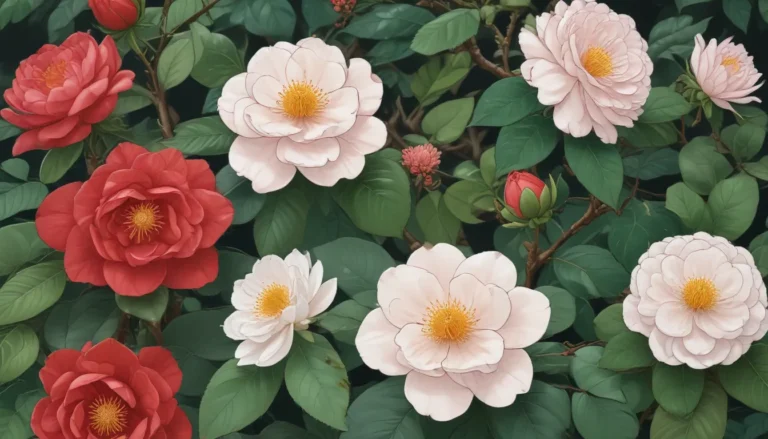How to Grow and Care for a Chinkapin Oak Tree: A Comprehensive Guide

Chinkapin oak, scientifically known as Quercus muehlenbergii, is a beautiful tree that belongs to the white oak group of the Fagaceae family. Native to central and eastern North America, this tree is a deciduous single-trunk shade tree that can grow up to 50-60 feet tall and wide, providing delightful shade for multiple generations to enjoy. In this article, we will delve into all the essential information you need to grow and care for a Chinkapin oak tree in your landscape.
What You’ll Learn
Let’s explore the journey of growing and nurturing a Chinkapin oak tree:
- Cultivation and History
- Propagation
- How to Grow
- Growing Tips
- Pruning and Maintenance
- Where to Buy
- Managing Pests and Disease
- Best Uses
- Quick Reference Growing Guide
Shall we begin our exploration of this magnificent tree?
Cultivation and History
It’s crucial not to mistake Quercus muehlenbergii with its chestnut relatives such as the Allegheny chestnut, Chinese chestnut, and Ozark chinquapin species. This oak tree boasts glossy, leathery leaves, narrow and lance-shaped, with an attractive texture and rich green color that transforms into a palette of yellow, orange, and brown hues in the fall.
The tree grows at a moderate rate, producing greenish male and female flowers that eventually mature into acorns. It can take up to 30 years for a tree to bear a crop of acorns, which are not only a delicacy for various wildlife but can also be consumed by humans after a careful preparation process to remove the bitter tannins they contain.
Propagation
Starting a Chinkapin oak tree can be done through seed sowing or by transplanting a nursery sapling. If you decide to start with seeds, ensure to select viable acorns by performing a simple water test. On the other hand, transplanting from nursery stock is a reliable way to kickstart the growth of your tree, especially if you want to avoid the uncertainty of seedling growth.
How to Grow
A Chinkapin oak tree thrives in full sun and demands well-draining soil with organic richness. Adequate watering is crucial, especially during the initial growth stages, and a slow-release fertilizer can be beneficial for optimal development. Careful attention to watering, fertilization, and mulching is necessary to ensure the tree’s health and longevity.
In times of drought, tools like soaker irrigation hoses and slow-release watering bags can help maintain moisture levels and nurture the tree during harsh conditions. Consulting an arborist for planting and care advice could also be a worthwhile investment to secure the tree’s prosperity.
Growing Tips
Here are some essential tips for cultivating a thriving Chinkapin oak tree:
- Full sun is essential.
- The ideal soil is slightly acidic to alkaline, organically rich, and well-draining.
- Consistent moisture is necessary, and watering must increase as the trunk grows wider.
- Fertilizer at planting time is not required and may be detrimental to root development.
- A large shade tree is an investment – consider hiring an arborist for planting and care.
Pruning and Maintenance
While Chinkapin oak trees are considered low-maintenance, they still require some upkeep, such as mulching, fertilizing, and periodic pruning to ensure their health and aesthetic appeal. Keeping an eye out for pests and diseases and seeking preventive measures can protect the tree from potential threats and contribute to its longevity.
Where to Buy
When purchasing a Chinkapin oak tree, selecting a reputable nursery is essential to ensure quality and zone-specific growth. Young oak trees from reputable sources are recommended for optimal adaptation to the transplanting process.
Managing Pests and Disease
While Chinkapin oak trees can thrive for over a century, they are susceptible to pests and diseases that can compromise their health. Preemptive measures, such as applying fungicides and insecticides, can help mitigate these risks and maintain the tree’s vitality.
Best Uses
Chinkapin oak is best utilized as a stand-alone specimen tree that can enhance the beauty and functionality of a landscape. Placing this tree on the south side of a home can provide optimal sun exposure and shade where needed, creating a harmonious outdoor environment.
Quick Reference Growing Guide
Here’s a quick reference guide for growing and caring for a Chinkapin oak tree:
- Plant Type: Deciduous tree
- Foliage Color: Green (yellow, orange, brown in fall)
- Native to: Central and eastern North America
- Hardiness (USDA Zone): 4-7
- Tolerance: Average soil, black walnut juglone, some drought
- Bloom Time: Spring
- Soil Type: Organically-rich loam
- Exposure: Full sun
- Soil pH: 5.0-8.2
- Time to Maturity: 30 years
- Soil Drainage: Well-draining
- Spacing: 50-60 feet
- Companion Planting: Beech, black walnut, chestnut, maple, oak
- Planting Depth: 3/4 to 1 inch deep (seeds); same depth as original container (transplants); roots with crown slightly above ground level (saplings in burlap)
- Uses: Landscape specimen, shade tree
A Living Legacy
In conclusion, cultivating a Chinkapin oak tree is a rewarding journey that can leave a lasting legacy for future generations to enjoy. By following best planting and care practices, you can nurture a majestic tree that will stand the test of time and enrich your landscape with its natural beauty and vitality.
Are you already growing a Chinkapin oak tree? Share your experiences and what you love most about this remarkable species in the comments below.
If you’re interested in exploring more large, long-lived landscape trees, check out our recommendations on Mulberry Trees, Hackberry Trees, and Hickory Trees.
Remember, with dedication and proper care, your Chinkapin oak tree will continue to flourish and thrive, becoming a cherished part of your outdoor sanctuary for years to come.
*





